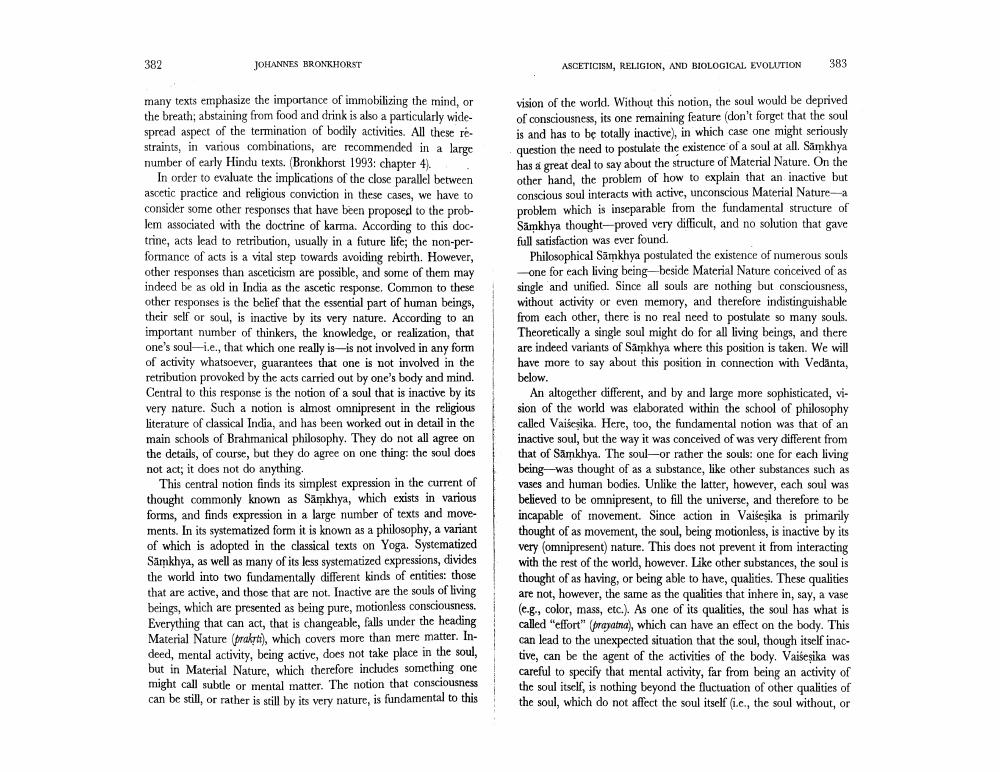Book Title: Asceticism Religion And Biological Evolution Author(s): Johannes Bronkhorst Publisher: Johannes Bronkhorst View full book textPage 5
________________ 382 JOHANNES BRONKHORST many texts emphasize the importance of immobilizing the mind, or the breath; abstaining from food and drink is also a particularly widespread aspect of the termination of bodily activities. All these restraints, in various combinations, are recommended in a large number of early Hindu texts. (Bronkhorst 1993: chapter 4). In order to evaluate the implications of the close parallel between ascetic practice and religious conviction in these cases, we have to consider some other responses that have been proposed to the problem associated with the doctrine of karma. According to this doctrine, acts lead to retribution, usually in a future life; the non-performance of acts is a vital step towards avoiding rebirth. However, other responses than asceticism are possible, and some of them may indeed be as old in India as the ascetic response. Common to these other responses is the belief that the essential part of human beings, their self or soul, is inactive by its very nature. According to an important number of thinkers, the knowledge, or realization, that one's soul-i.e., that which one really is-is not involved in any form of activity whatsoever, guarantees that one is not involved in the retribution provoked by the acts carried out by one's body and mind. Central to this response is the notion of a soul that is inactive by its very nature. Such a notion is almost omnipresent in the religious literature of classical India, and has been worked out in detail in the main schools of Brahmanical philosophy. They do not all agree on the details, of course, but they do agree on one thing: the soul does not act; it does not do anything. This central notion finds its simplest expression in the current of thought commonly known as Sämkhya, which exists in various forms, and finds expression in a large number of texts and movements. In its systematized form it is known as a philosophy, a variant of which is adopted in the classical texts on Yoga. Systematized Samkhya, as well as many of its less systematized expressions, divides the world into two fundamentally different kinds of entities: those that are active, and those that are not. Inactive are the souls of living beings, which are presented as being pure, motionless consciousness. Everything that can act, that is changeable, falls under the heading Material Nature (prakti), which covers more than mere matter. Indeed, mental activity, being active, does not take place in the soul, but in Material Nature, which therefore includes something one might call subtle or mental matter. The notion that consciousness can be still, or rather is still by its very nature, is fundamental to this ASCETICISM, RELIGION, AND BIOLOGICAL EVOLUTION 383 vision of the world. Without this notion, the soul would be deprived of consciousness, its one remaining feature (don't forget that the soul is and has to be totally inactive), in which case one might seriously question the need to postulate the existence of a soul at all. Samkhya has a great deal to say about the structure of Material Nature. On the other hand, the problem of how to explain that an inactive but conscious soul interacts with active, unconscious Material Nature-a problem which is inseparable from the fundamental structure of Samkhya thought-proved very difficult, and no solution that gave full satisfaction was ever found. Philosophical Samkhya postulated the existence of numerous souls one for each living being beside Material Nature conceived of as single and unified. Since all souls are nothing but consciousness, without activity or even memory, and therefore indistinguishable from each other, there is no real need to postulate so many souls. Theoretically a single soul might do for all living beings, and there are indeed variants of Samkhya where this position is taken. We will have more to say about this position in connection with Vedanta, below. An altogether different, and by and large more sophisticated, vision of the world was elaborated within the school of philosophy called Vaisesika. Here, too, the fundamental notion was that of an inactive soul, but the way it was conceived of was very different from that of Samkhya. The soul-or rather the souls: one for each living being was thought of as a substance, like other substances such as vases and human bodies. Unlike the latter, however, each soul was believed to be omnipresent, to fill the universe, and therefore to be incapable of movement. Since action in Vaiseṣika is primarily thought of as movement, the soul, being motionless, is inactive by its very (omnipresent) nature. This does not prevent it from interacting with the rest of the world, however. Like other substances, the soul is thought of as having, or being able to have, qualities. These qualities are not, however, the same as the qualities that inhere in, say, a vase (e.g., color, mass, etc.). As one of its qualities, the soul has what is called "effort" (prayatna), which can have an effect on the body. This can lead to the unexpected situation that the soul, though itself inactive, can be the agent of the activities of the body. Vaiseṣika was careful to specify that mental activity, far from being an activity of the soul itself, is nothing beyond the fluctuation of other qualities of the soul, which do not affect the soul itself (i.e., the soul without, orPage Navigation
1 ... 3 4 5 6 7 8 9 10 11 12 13 14 15 16 17 18 19 20 21 22 23
